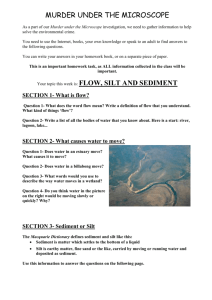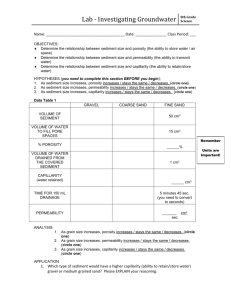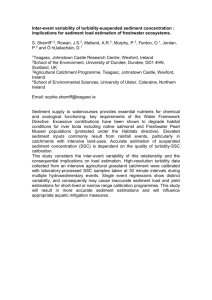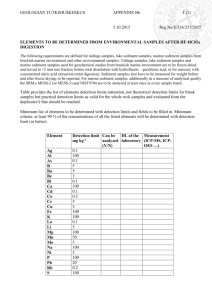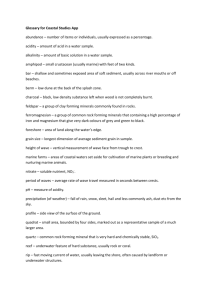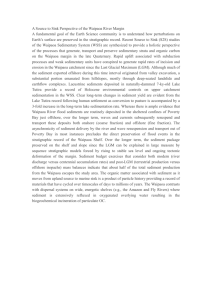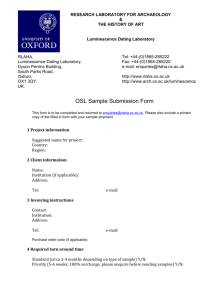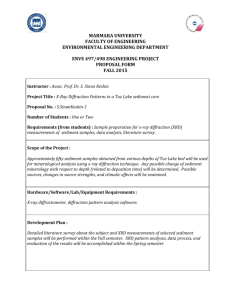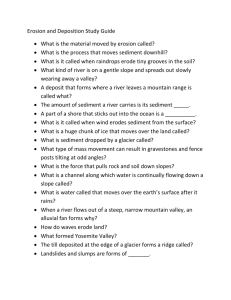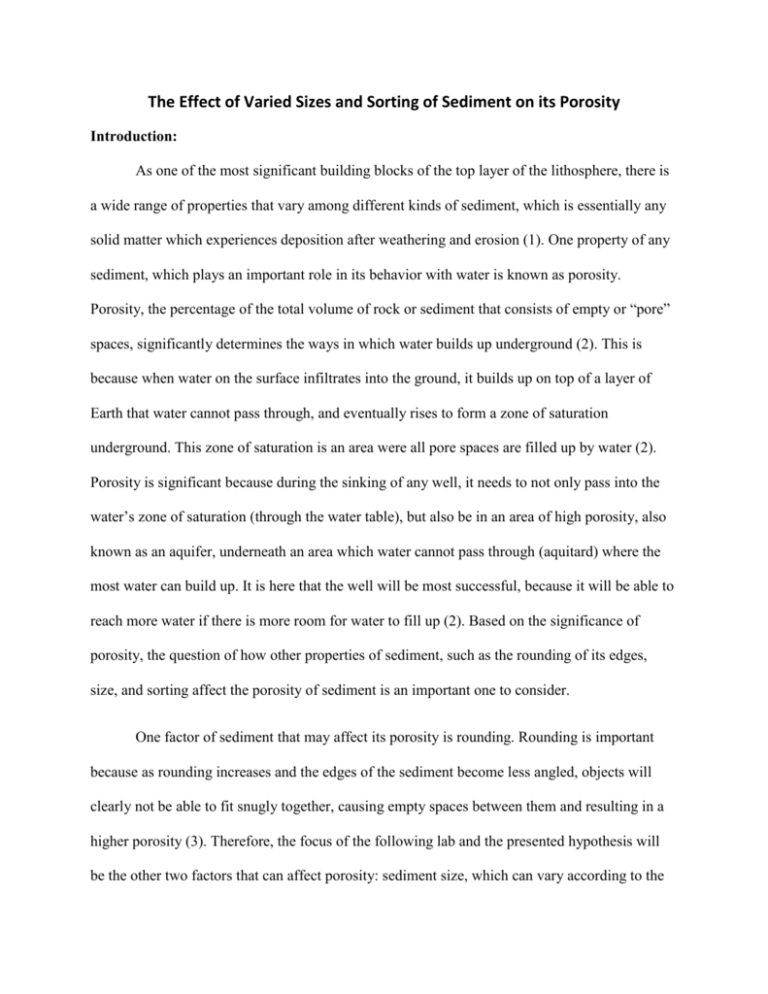
The Effect of Varied Sizes and Sorting of Sediment on its Porosity
Introduction:
As one of the most significant building blocks of the top layer of the lithosphere, there is
a wide range of properties that vary among different kinds of sediment, which is essentially any
solid matter which experiences deposition after weathering and erosion (1). One property of any
sediment, which plays an important role in its behavior with water is known as porosity.
Porosity, the percentage of the total volume of rock or sediment that consists of empty or “pore”
spaces, significantly determines the ways in which water builds up underground (2). This is
because when water on the surface infiltrates into the ground, it builds up on top of a layer of
Earth that water cannot pass through, and eventually rises to form a zone of saturation
underground. This zone of saturation is an area were all pore spaces are filled up by water (2).
Porosity is significant because during the sinking of any well, it needs to not only pass into the
water’s zone of saturation (through the water table), but also be in an area of high porosity, also
known as an aquifer, underneath an area which water cannot pass through (aquitard) where the
most water can build up. It is here that the well will be most successful, because it will be able to
reach more water if there is more room for water to fill up (2). Based on the significance of
porosity, the question of how other properties of sediment, such as the rounding of its edges,
size, and sorting affect the porosity of sediment is an important one to consider.
One factor of sediment that may affect its porosity is rounding. Rounding is important
because as rounding increases and the edges of the sediment become less angled, objects will
clearly not be able to fit snugly together, causing empty spaces between them and resulting in a
higher porosity (3). Therefore, the focus of the following lab and the presented hypothesis will
be the other two factors that can affect porosity: sediment size, which can vary according to the
environment in which the sediment forms (at the bottom of an ocean or in fast-moving steam),
and sorting, which depends on the path that sediment takes to its destination (a sieve/narrow
rocks or an open passage). Firstly, sediment size can affect porosity because as it increases, each
grain that makes up the sediment will take up more space and be more awkwardly placed to fit
into its given container, preventing sediment from forming evenly. Consequently, an increase in
sediment size has the potential to create large gaps inside the sediment. The other factor, known
as sorting, is essentially how uniform the size of the grains within the sediment is. As sorting
increases, grain sizes of the sediment will tend to be of one specific size, while an unsorted
sample of sediment can contain sediment of a variety of different sizes. Sorting can impact
porosity because the more sorted a sample of sediment is, the less smaller grains there will be to
fit in between the gaps that larger grains form. Therefore, it is predicted that given an increase in
sediment size, porosity will increase due to larger gaps inside the sediment, and that an increase
in the sorting/uniformity of the sediment (well sorted) will cause porosity to increase as less
small grains exist to fill up spaces created by larger grains.
Methods:
In this lab, a graduated cylinder was placed on a scale, which was “zeroed out”. Then, a
measured amount of large and small sediment was placed into the graduated cylinder, up to 20
milliliters. The mass of this sediment was recorded. Then, water was carefully poured in, until it
reached the top of the sediment. The added mass due to the added water was displayed on the
scale, and was also recorded. Since one gram of water is equal to one milliliter, the volume of the
added water was equal to the mass of the water that fit into the pore spaces of the sediment,
measurable by subtracting the original mass of the water-less cylinder from the mass after water
was poured into it. The following sets of small and large sediment were used in each run-through
of the lab: 20 mL large and 0 mL small, 15 mL large and 5 mL small, 10 mL both large and
small, 5 mL large and 15 mL small, and finally 0 mL larges and 20 mL small grains.
Results:
In Figure 1, the percentage (%) of small grains used in each step of that lab was graphed with
the resulting porosity.
Figure 1
60
50
40
30
20 Small
20 Large
20
10
Sorted
Sorted
Unsorted
Sample Calculation of Porosity (using data from appendix):
Steps and Labels
Calculation | Value
Explanation
1. Mass Without Water (g)
N/A | 11.31
Mass of sediment when poured
into a graduated cylinder up to 20
mL, with the cylinder “zeroed” out
on the scale
2. Mass With Water (g)
N/A | 19.95
#1 in addition to water poured until
reaching 20 mL
3. Volume of Water (mL)
19.95 – 11.31= | 8.64
The mass of the original sediment
subtracted from the new mass after
water was poured in. Is equal to
the mass of water because water’s
density is exactly 1.00 g/mL
4. Volume of Everything (mL)
N/A | 20 mL
The standard measure to which the
water and sediment was filled up
to
5. Porosity (%)
8.64 / 20= | 43.2%
The volume of water that could fill
up the pores in the sediment
divided by the standard volume of
everything
6. Small Sediment Percentage
(%)
0/20= | 0%
The number of mL of small beads
divided by the total mL of
everything
Discussion:
Prior to performing the lab, it was hypothesized that as the use of large sediment
increased, the porosity of the sediment would also increase. To determine whether the lab’s
results support the hypothesis, it is necessary to observe the first and last points on the graph.
When there is 0% small sediment, this shows that 20/20 beads in the graduated cylinder were
large while 0/20 where small. Then, when the percentage reaches 100%, there are 0/20 large
beads in the cylinder and 20/20 small beads. It is these two points that represent the two extremes
of the experiment. This is because any points in between 0 and 100% small sediment are
simultaneously demonstrating the effect of sorting, and are therefore not useful to determine the
effect of size. However, by only observing the two extremes, it is possible to determine exactly
how much a uniform increase in size, without a change in sorting, can have on porosity. In the
graph, and within the data table (see appendix), it can be seen that while the porosity of 20 mL of
small sediment is 43.2%, the large sediment’s porosity is over 5% higher, at 48.45%. This 5%
increase is enough to support the first half of the hypothesis, and reveals that an increase in
sediment size directly equates to an increase in porosity. This correlation between grain size and
porosity is due to the fact that as sediment size increases, the void or “pore” spaces between noncompacted grain sizes increases as well, and this small increase ads up for each of the many
grains within the sediment to create more overall pore space within the sediment, which water is
able to fill up (3).
Furthermore, the hypothesis also predicted that well sorted sediment would result in
higher porosities than poorly sorted sediment, or that a decrease in the sorting of sediment would
cause a decrease in porosity. In the graph, data points that have 0% or 100% small sediment both
represent extremely well sorted sediment, and as points become closer to 50% small sediment,
the quality of the sorting gradually decreases. This is because 0% small sediment represents a
cylinder that is entirely composed of large sediment, while 100% small sediment shows that
there was no large sediment within the cylinder. However, at 50% small sediment, both bead
types compose exactly half of the sediment’s volume, and points in between such as 25% and
75% represent a slight bias towards one of the two sizes.
In the graph, it is evident that sorting did in fact play a key role in determining the
porosity of each sample. This is because throughout the length of the graph, a shape similar to an
upside down parabola has formed, with porosity decreasing as the sample’s small sediment
percentage nears 50%, and increasing as the data’s percentage reaches 0% and 100%. However,
interestingly, the sediment sample with the least porosity is not the one with the worst sorting,
but in fact the one that had slightly more small sediment than large (75%). This most likely
relates to the previous conclusion about the effect of smaller sized sediment on porosity, because
the 75% small sample demonstrates an optimal mix in a high amount of small sediment,
combined with a moderate amount of mix between the two sizes. It is this sediment that had a
record low porosity of 38.95%, which when compared to the almost 10% higher 48.45% porosity
of the uniformly large sample, demonstrates the large negative impact that poor sorting can have
on porosity. Furthermore, the increase in porosity given more sorting on both ends of the graph,
from 25% small to 0% small sediment (a 5% increase in porosity), and 75% small to 100%
small porosity (a ~4% increase), demonstrates that no matter the sediment size, a uniform
sediment size (well sorted) directly equates to an increase in porosity, and vice versa. This
evidence, best found within the “U” or “parabola” shape in the graph, reveals that the second part
of the previously made hypothesis, that an increase in sorting in sediment (well sorted) will result
in an increase in sediment porosity, is also supported by the lab. The effect of sorting on porosity
is due to the fact that as grain sizes vary throughout the sediment sample, the smaller grains
become capable of infilling the spaces that form between the larger grains, reducing the amount
of empty space between each grain (3). This is why the more well-sorted a sediment becomes,
the less smaller grains there are to take up spaces created by larger grains, leaving much more
empty space (4). Based on these results, it is possible to conclude that the hypothesis is fully
supported by the lab data, and that as sediment size and sorting increase, so does porosity.
Although the lab seemed to accurately portray the logical effects of grain size and sorting on
porosity that does not mean that it did not have sources of error. For example, the lab’s methods
did not account for the order in which sediment sizes were dropped into the graduated cylinder.
If the large grains were by some chance placed on top of the smaller grains, the porosity would
have been much higher than if the opposite were true, because the smaller grains would not have
been given an opportunity to seep into the large pores created by the large grains. Therefore, a
way in which the lab could be improved would be to place all of the large grains inside the
graduated cylinder first, and then place all of the small grains in.
Furthermore, another source of error was that due to the irregular size of circular grains,
it was not possible to measure when exactly 20 mL of the graduated cylinder had been filled
during the waterless portion of the experiment. Therefore, readings may have been off by 1-2
mL, resulting in skewed results, as either not enough or too many beads were considered to have
a volume of 20 mL. This was also only specific to the large beads, because smaller beads were
easier to fill up to a precise height on the graduated cylinder, due to the higher level of fine
tuning that they allowed. One way in which the lab could have been improved to deal with this
source of error would be for a stopper or some other object that could fit inside the cylinder to be
used, to squish the sediment into a confined volume, to test volume under pressure. While
porosity is an important feature of sediment, it is not the only one that is relevant within the field
of Earth Science.
Another property that often goes hand in hand with porosity, and is mostly affected by
similar factors, is permeability. Permeability is the ability of sediment to transmit water or other
fluids. The greater the permeability of a rock, the easier substances such as water will be able to
flow through it (2). Interestingly, one factor that increases both porosity and permeability is the
grain size of sediment. This is because when the grain size is smaller, the permeability is lower,
due to the fact that water cannot pass through the smaller pore spaces as fast as it could pass
through the larger pore spaces (4). Some samples, such as clay, have a high porosity, but are
impermeable, because the pore spaces are so small that the water cannot pass through them.
Grain packing also affects permeability in the same way. The tighter the grain particles are
pushed together, the smaller the pore spaces will be, and therefore water will not be able to pass
through the pore spaces as efficiently as larger pore spaces (4). Cementation, the binding
together of particles and other materials by mineral bonds, can also greatly affect permeability. If
minerals have already seeped into pore spaces and are helping the rock particles to stick together,
there are little to no pore spaces, and therefore water cannot pass through them (4). Therefore,
features of extremely permeable sediment would be for it to fit into a large space (with little
pressure, allowing for little grain packing), for it to have large pore spaces caused by large grain
size, and to be un-cemented or barely cemented together so that bonds between the grains do not
prevent water’s flow.
Porosity and permeability are relevant to the modern day world because they are essential to
building wells, due to the fact that they affect the way that groundwater is stored, water which
wells take from (2). When permeability is higher, generally groundwater is able to seep through
these pores quicker. Then, when combined with sediment that is porous and can hold large
amounts of groundwater, an aquifer is formed. However, sometimes the pores of sediment or
rocks are too small for water to flow through, such as clay. When this happens, the rock may
still have a high porosity, but it is impermeable, because no water can pass through it. A highly
impermeable surface is known as an aquitard. The formation of aquitards and aquifers based on
rock-specific properties that influence permeability and porosity is important because when an
aquifer is placed above an aquitard, a water table is formed. This is the area in which
groundwater will build up, but cannot go any lower than due to the impermeable rock below it.
Finally, it is important to consider that an effective way to measure permeability of sediment
is through the amount of liquid that can pass through it within a given time (5). In fact, this way
of measuring permeability would make for a way to test out how different grain sizes affect it.
The effect of grain size on permeability could be most efficiently tested by performing the same
test on 2-3 sediment samples, that all contain a uniform set of grains, each sediment sample with
a different size. Water be poured over this sediment, and collected underneath it, in a period of
several seconds, depending on the volume of water poured. Then, the volume of water that
passed through the sediment could be divided by the number of seconds it was timed under, a
lower ratio meaning low permeability and a high water/time ratio meaning sediment that is very
permeable. Although permeability and porosity are not clearly visible properties within sediment
that humans witness in effect every day, their effect on sediment, and its interaction with
groundwater, is highly essential to understanding the way in which humans build wells and
collect water.
Appendix:
Measurement/Data
Mass Without Water (g)
Mass With Water (g)
Volume of Water (cm3)
Volume of Everything
(cm3)
Porosity (%)
Small:Large Ratio
20 Sm
15 Sm 5 Lg
10 Sm 10 Lg
5 Sm 15 Lg
20 Lg
(mL)
(mL)
(mL)
(mL)
(mL)
11.31
11.34
11.01
10.71
10.45
19.95
19.13
19.01
19.6
20.14
8.64
7.79
8
8.89
9.69
20
43.2
100%
20
38.95
75%
20
40
50%
20
44.45
25%
20
48.45
0%
Bibliography:
1. "Sediment." ScienceDaily. Ed. Dan Hogan. ScienceDaily. Web. 14 Mar. 2012.
<http://www.sciencedaily.com/articles/s/sediment.htm>.
2. Tarbuck, Edward J., Frederick K. Lutgens, and Dennis Tasa. Prentice Hall Earth Science.
Needham, Mass. ; Upper Saddle River, N.J.: Pearson/Prentice Hall, 2006. Prin
3. Thorbjarnarson. "Porosity." SDSU. San Diego State University, 2005. Web. 19 Mar. 2012.
<http://www.geology.sdsu.edu/classes/geol351/porosity.htm>."Porosity and
4. Permeability." Enotes.com. Ed. Brenda Lerner. Enotes.com, 2001. Web. 19 Mar. 2012.
<http://www.enotes.com/porosity-permeability-reference/porosity-permeability>.
5. Thompson, Jane. "Permeability." FAO.org. FAO.org. Web. 21 Mar. 2012.
<ftp://ftp.fao.org/fi/CDrom/FAO_Training/FAO_Training/General/x6706e/x6706e09.htm>.

